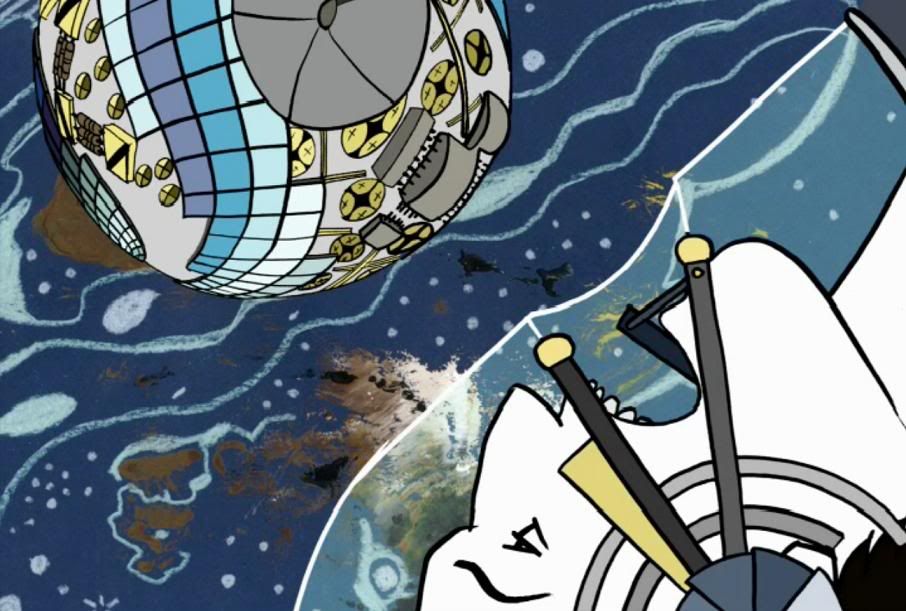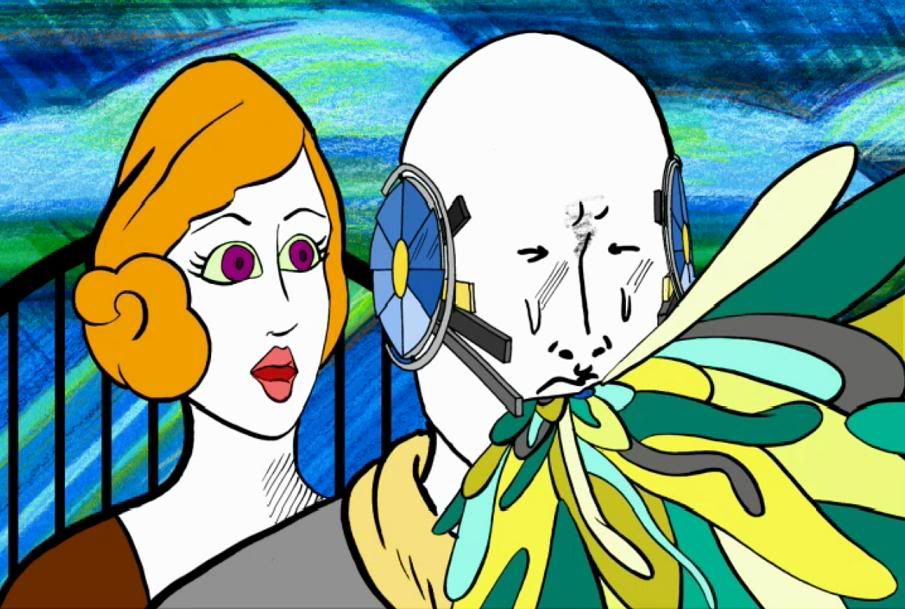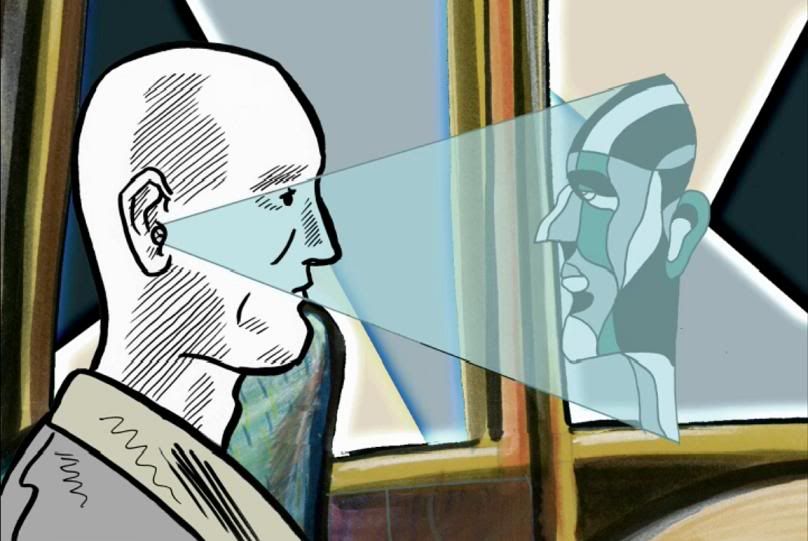
The Unclothed Man in the 35th Century A.D. is the new IFC.com web series from comic artist Dash Shaw, representing his first venture into an animated series after establishing himself as one of modern comics' most innovative and unusual formalists. The series, which can be viewed in its entirety for free at the IFC site, consists of four episodes, each roughly two minutes long, applying Shaw's characteristic style — a blend of clean-line cartooning, diagrammatic precision, and stylistic collage — to the animated form. Shaw is an astonishingly precocious young artist, who in the last few years has progressed from the sketchy but intriguing formalism of his short story collection Goddess Head to the fully flowering imagination on display in his 700-page tour-de-force family drama Bottomless Belly Button and, more salient to this film, in the online strip Bodyworld and his sci-fi contributions to the Mome anthology. It's the style of these stories, which exploit Shaw's idiosyncratic use of color overlays, that directly led to the style of The Unclothed Man.
The Unclothed Man, like most of Shaw's work, is concerned first and foremost with ways of visually representing complex and difficult-to-express ideas, with ways of looking at and understanding the world. As in Shaw's very similar Mome stories, the film uses a slim sci-fi premise as a hook to examine an unusual experience and its effect on the human body and mind. Shaw is continually dissecting experiences, stretching out time so that each component of a moment might be studied in depth. In Bodyworld, he portrays the subjectivity of drug experiences and various metaphysical states, while some of his short stories deal with intradimensional travel and overlapping worlds. In Bottomless Belly Button, the anthropomorphized appearance of one character — in a cast otherwise consisting of humans — is a reflection of that character's opinion of himself, his feeling of being an outcast.

In The Unclothed Man, these tropes play out in the way Shaw examines the experience of modeling for an art class while trying to maintain a rigid, unmoving posture. The film's hero is a rebel agent in a future where human-like droids have taken over many routine tasks, including that of modeling for artists. As part of an anti-droid rebel resistance, the hero Rebel X-6 poses as a droid in an art class, shaving himself and taking pills to maintain a stiff, robot-like stasis. The second episode, in which X-6 poses nude for a drawing class, breaks down his experience with a montage of body parts, each one accompanied by pop-up captions describing the sensations coursing through his body, as the art style gracefully shifts between various modes, from charcoal shading to Photoshop-style filters, reflecting the ease with which the future's artistic processes allow artists to mold their computer-generated "drawings."
It's this fluidity that makes The Unclothed Man so dazzling and exciting. Shaw juxtaposes different styles within the frame, allowing his more cartoony characters — like the big-nosed art class instructor, a callback to old-school newspaper comic stereotypes — to clash against the mannequinesque minimalism of his central character or the wavy, giraffe-like curves of the drawing student who takes a special interest in X-6. Similarly, various emotional and physical states interweave in interesting ways, so that a scene that might at first seem to be an objective observation from a distance opens up into an examination of X-6's inner reactions and psychological/physical responses. The second episode closes with "a dream," in which abstract designs swirl and congeal into Freudian psychosexual images, Masonic/conspiratorial symbology, and eventually a maze of cartoon symbols, the building blocks of a drawn language. It's all very self-consciously about representing ideas and emotions through the drawing, through the line and the symbol; the words "a dream" themselves, placed before this sequence, quickly morph into rows of teeth as the boxes surrounding the words form the outline of a mouth.

As far as incident goes, the film's plot is almost inanely simple, and the brief "synopses" included with each episode mock the film's plotless ambling. It's all so much more about the imagery and internal wanderings triggered by the basic situation. In the first episode, we're introduced to Rebel X-6 through one of his missions-in-progress, which plays out in a mix of conventional animation with interludes that mimic old text-based computer games, with blocky computer type scrolling across the screen. The mission apparently consists of the rebel destroying a droid outpost using something called a "black hole mouth," but Shaw introduces high-concept sci-fi accoutrements like this only as an excuse to display some stunning imagery, in this case the rebel spaceman floating through the void, sucking an orbiting satellite into a swirl of color that streams into his mouth like water down a drain hole. Space, in Shaw's conception, looks like a crayoned child's drawing. His sense of color, always strong, is especially vivid at moments like this, when what's actually happening becomes abstracted into blocks of pure color. Later in the episode, Shaw details X-6's preparations for his modeling assignment, particularly his process of shaving: a closeup looks like the diagrammatic inserts in a Schick commercial, showing the blades of a razor plucking hairs from their pores. These micro-processes interest Shaw, who's always examining what's going on with his protagonist at the physiological level, whether it's his struggle not to sweat (droids don't sweat!) or his paranoia about a non-existent pimple that might break his cover.
Other episodes are similarly introspective and devoid of drama. The second episode concerns itself with X-6's subjective experience of posing, the creation of art in the technology-driven 35th Century, and X-6's symbolic dream. In the third episode, X-6 as a model droid unexpectedly forms a connection with an artist, and passes out from the physical strain of modeling. This tirggers another subjective abstraction, as his fainting spell is visualized by Rothko-like color fields blurring and overlapping. He then finds himself in a room that's like a catalogue of 20th Century art, culture, technology and design, the past encroaching upon the future. It seems the artist who's interested in X-6 has a nostalgic tendency, a desire for a connection with the past that's otherwise absent in this obsessively forward-looking culture. Finally, in the fourth episode, mirroring the first, X-6 reveals himself as an anti-droid rebel and once again utilizes his "black hole mouth," sucking in an entire world, blurring everything together as though mixing paints. This time, though, the act of destruction becomes a metaphor for sexuality, for union as mouths and tongues join together into one form, one drawing.

The Unclothed Man in the 35th Century A.D. is a fascinating first animated work from one of today's most original and unusual artists. Shaw adapts well from the comics page to the cinematic form. His animation (assisted by Jane Samborski, working from Shaw's drawings) is sometimes stiff and overly static, and some of his "camera" moves are slightly awkward, betraying the fact that Shaw is a newcomer to cinema. He sometimes seems to be still rooted in comics, as his heavy reliance on text suggests; to be fair, though, the text is in nearly every case inventively incorporated into the image, as one more visual element, rather than treated simply as a way to tell the story without dialogue or spoken narration. There's very little spoken dialogue in the film, just a few garbled transmissions from X-6's superiors, but strangely enough one hardly misses it. The low-key soundtrack, by James Lucido, is in any case a perfect complement to Shaw's immersive images.
In other ways, too, Shaw brings to animation the same restless curiosity about form that runs through all his comics work. At one point, conveying movement, he has a character race across the frame, and surrounds him with an arrow-shaped border, blending the kinetic language of film with the static, symbolic language of comics. The arrow, strictly unnecessary to convey motion since the character is actually moving, works instead as a meta intrusion, a reminder of the film's obsession with expressing abstract concepts and subjective experiences visually. At the end of the sequence, as a flying ship crashes to ground, the arrow condenses into a tiny irregular triangle, a slash of visible space within a black void.
Though Shaw is only just beginning to explore animation, The Unclothed Man already displays evidence of the cartoonist's affinity for animation. Almost as well as his comics, this film expresses Shaw's ongoing desire to look at the world from a slightly askew perspective, to express his fascination with the complexity of people's inner universes. Thus, sci-fi is perhaps the perfect genre for him, even though he's suggested that after this film he's going to abandon sci-fi for at least a while. The form allows him to map his visualizations of inner realities onto various equally stylized outer realities, whether that's the black of space, temporal intersection points, or the distant future. Shaw's first animated film is very much worth viewing for anyone interested in checking out one of modern art's freshest and most consistently challenging new artists. As a bonus, IFC has made available, as "extras," a complete Shaw comic (Look Forward, First Son of Terra Two, from Mome) and several wallpapers (including nice tributes to Gus Van Sant and Guy Maddin). Of course, as welcome as these extra tidbits are, it's the film itself — a probing, emotional examination of what it means to make art and to forge meaningful human interactions — that should be the main draw.
No comments:
Post a Comment